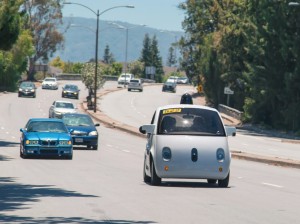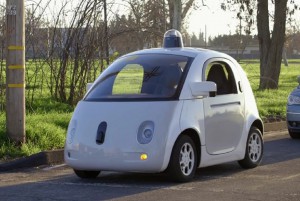Unless you’re on Prozac or are a serious practitioner of Zen, you likely know the discrete pleasure of blowing your horn to remind some fool of their roadway indiscretions.
Okay, leaning on the horn is often just a prelude to the full-fledged onset of road rage, but there are times it’s the only way to alert another driver, perhaps that the light has changed or that they’re drifting into your lane. In fact, we do a lot more signaling to one another when we’re behind the wheel than you might realize, whether with horn, hand gesture, nods or turn signals. And that’s a potentially serious problem for autonomous vehicles.
Already working on ways to get its self-driving prototypes to think more like human motorists, Google is now working to teach its autonomous vehicles when and how to honk their horns.
“Our self-driving cars aim to be polite, considerate, and only honk when it makes driving safer for everyone,” says Google’s monthly report on its autonomous vehicle program. “During testing, we taught our vehicles to distinguish between potentially tricky situations and false positives, i.e. the difference between a car facing the wrong way during a three-point turn, and one that’s about to drive down the wrong side of the road.”
Google currently operates a fleet of 58 autonomous prototypes, 24 modified Lexus SUVs and another 34 “Google Cars,” specially designed vehicles assembled by Detroit-based supplier Rousch. The goal is to soon have 100 of the latter models on hand, all driven by whisper-quiet electric motors. Google also announced this spring an alliance with Fiat Chrysler that will see its autonomous technology integrated into a small fleet of the new Chrysler Pacifica Hybrid minivans.
The company is already testing its vehicles in four cities, including its home campus of Mountain View, California. And it is now setting up a test hub in the Detroit suburbs. A key goal is to expand the range of weather and road conditions in which those prototype vehicles operate.
(Big changes coming for Dodge Charger and Challenger models. For more, Click Here.)
Google has been involved in almost 20 crashes while logging 1.6 million miles of testing over the past seven years. It claims only one of those incidents was the fault of its autonomous technology, but it has also acknowledged that those vehicles need to better understand how humans drive. Instead of slamming on the brakes at a yellow light, for example, it may make more sense to continue forward and make a left turn.
Another challenge is how to communicate with other drivers – as well as bicyclists and pedestrians. Eventually, all cars are expected to be outfitted with vehicle-to-vehicle and vehicle-to-infrastructure communications systems but, for now, drivers and pedestrians routinely nod, wave or otherwise signal to one another. It makes it safer and easier to negotiate four-way stops, for example, or give a person on foot the right of way.
Giving an autonomous car the ability to honk is one step. The Google cars can either sound two blips or one longer toot, and initially, the horns only sounded inside the vehicle so engineers could see if they did the right thing.
(Click Here to find out what’s hot for 2017.)
“Our goal is to teach our cars to honk like a patient, seasoned driver,” explained the monthly report. “As we become more experienced honkers, we hope our cars will also be able to predict how other drivers respond to a beep in different situations.”
Not all situations can be dealt with by blowing a horn, however, and researchers are looking at other forms of communications. Nissan has actually brought an anthropologist in-house to study ways drivers signal one another and communicate with pedestrians. One possible solution will be to mount signal lights on the exterior of autonomous vehicles that would function as the alternative to a nod or wave.
Indeed, some autonomous programs are using special indicator lights on their prototypes so the rest of the world knows there’s no driver.
(To get an early look at the new Audi A5, Click Here.)
Projects like the Google autonomous vehicle program will have to make sure their technology can handle every possible situation a human driver might encounter. That means things like poorly marked roads, bad pavement, inclement weather and distracted drivers. But it will also mean finding ways for autonomous vehicles to talk and signal everyone else sharing the roads.



While working at OnStar I created an invention around utilizing the telematics unit to govern noisemaking for vehicles…interesting application here.